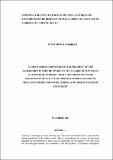| dc.description.abstract | Globally, improving service delivery has received considerable focus with reforms being introduced in the public sector. This is being driven by a focus on increased demand for governments to seek ways of improving service quality. Over the years the Kenyan government has contended with the problem of runaway corruption, discourtesy, unresponsiveness and bureaucratic delays in its public service. To address the problem, the government introduced the concept of Huduma Centres (One Stop Shops) in 2013 as a strategy to reform the public service. The study therefore sought to examine the effectiveness of Huduma Centres in the delivery of public services in Nairobi City County. The specific objectives of the study were; to examine whether Huduma centres influence compliance with public service principles; to assess customers’ perceptions of the front line staff at Huduma centres, to ascertain whether Huduma Centres result into customer satisfaction with the services offered and to establish challenges faced by Huduma centres. The study used descriptive research design. The study made use of Expectancy Disconfirmation Theory and Assimilation - Contrast Theory. The study population constituted individual citizens seeking services at the centres and the centre managers as key informants. The study used convenience and purposive sampling methods to select three hundred and seventy (370) respondents and four centre managers respectively. The data collection instruments used were questionnaires and in-depth interview schedules. Descriptive statistics were used in data analysis. The study findings indicated that Huduma centre service delivery model enhances transparency and decreases the risk of corruption, the digitalized system makes it difficult for unethical behaviours to thrive, institutional services have been brought under one place thereby significantly improving timeliness in service delivery, the combination of multiple government services into one location leveraging technology to automate services has enabled Huduma centres to realize strong efficiency gains, frontline staff are friendly and courteous. Majority of the customers were satisfied with user friendliness, range of services provided, service quality, ambience and location of the centres. From the study findings, 77 % of the respondents observed that service delivery under the model is getting better, 95.5 % of them would seek services from the centres in future while 85.2% of them would recommend the centres to others. Conversely, the study revealed that Huduma centres lack customer feedback mechanisms to evaluate performance, majority of the respondents were not satisfied with speed, operating hours and complaint management processes. The study identified reconciling the needs of different service seekers, sustaining a motivated workforce, limited resources, sustainability of quality services, system breakdowns, delays in some counters and inadequate staff as some of the challenges. The study recommended the incorporation of citizen feedback in the governance processes of Huduma centres, continuous improvement and self-evaluation, strengthening existing anti-corruption systems, division of the service area into three areas namely; self service area, area for quick services and the area for long services as well as granting the Huduma Kenya secretariat the Parastatal status with full autonomy to function and hire own staff. | en_US |

